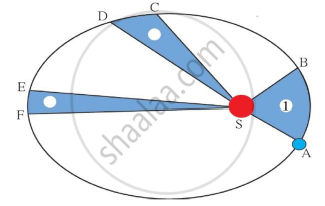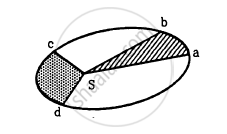Advertisements
Advertisements
प्रश्न
Let us assume that our galaxy consists of 2.5 × 1011 stars each of one solar mass. How long will a star at a distance of 50,000 ly from the galactic centre take to complete one revolution? Take the diameter of the Milky Way to be 105 ly
उत्तर १
Mass of our galaxy Milky Way, M = 2.5 × 1011 solar mass
Solar mass = Mass of Sun = 2.0 × 1036 kg
Mass of our galaxy, M = 2.5 × 1011 × 2 × 1036 = 5 ×1041 kg
Diameter of Milky Way, d = 105 ly
Radius of Milky Way, r = 5 × 104 ly
1 ly = 9.46 × 1015 m
∴r = 5 × 104 × 9.46 × 1015
= 4.73 ×1020 m
Since a star revolves around the galactic centre of the Milky Way, its time period is given by the relation:
`T = ((4pi^2r^3)/(GM))^(1/2)`
= `((4xx(3.14)^2xx (4.73)^2 xx 10^(60))/(6.67xx10^(-11)xx5xx10^(41)))^(1/2) = ((39.48xx105.82xx10^(30))/33.35)^"1/2"`
= `(125.27 xx 10^(30))^(1/2) = 1.12 xx 10^(16) s`
1 year = `365 xx 324 xx 60 xx 60 s`
1s = `1/(365xx24xx60xx60)` year
`:.1.12xx10^(16) s = (1.12 xx 10^(16))/(365xx24xx60xx60)`
= `3.55 xx 10^8` year
उत्तर २
Here, r = 50000 ly = 50000 x 9.46 x 1015 m = 4.73 x 1020 m
M = 2.5 x 1011 solar mass = 2.5 x 1011 x (2 x 1030) kg = 5.0 x 1041kg
We know that
`M =(4pi^2r^3)/(GT^2)`
or` T = ((4pi^2r^3)/"GM")^(1/2) = [(4xx(22/7)^2xx(4.73xx10^(20))^3)/(6.67xx10^(-11)xx(5.0xx10^(41)))]^(1/2)`
= `1.12 xx 10^(16)` s
APPEARS IN
संबंधित प्रश्न
A Saturn year is 29.5 times the earth year. How far is the Saturn from the sun if the earth is 1.50 ×108 km away from the sun?
State Kepler's laws of planetary motion.
Identify the law shown in the figure and state three respective laws.

In the Following figure shows the elliptical path of a planet about the sun. The two shaded parts have equal area. If t1 and t2 be the time taken by the planet to go from a to b and from c to d respectively,

Answer the following question.
State Kepler’s law of the period.
Observe the given figure and answer these following questions.

The orbit of a planet moving around the Sun
- What is the conclusion about the orbit of a planet?
- What is the relation between velocity of planet and distance from sun?
- Explain the relation between areas ASB, CSD and ESF.
The mass and radius of earth is 'Me' and 'Re' respectively and that of moon is 'Mm' and 'Rm' respectively. The distance between the centre of the earth and that of moon is 'D'. The minimum speed required for a body (mass 'm') to project from a point midway between their centres to escape to infinity is ______.
Supposing Newton’s law of gravitation for gravitation forces F1 and F2 between two masses m1 and m2 at positions r1 and r2 read F1 = – F2 = `- r_12/r_12^3 GM_0^2 ((m_1m_2)/M_0^2)^n` where M0 is a constant of dimension of mass r12 = r1 – r2 and n is a number. in such a case.
- the acceleration due to gravity on earth will be different for different objects.
- none of the three laws of Kepler will be valid.
- only the third law will become invalid.
- for n negative, an object lighter than water will sink in water.
Out of aphelion and perihelion, where is the speed of the earth more and why?
Earth’s orbit is an ellipse with eccentricity 0.0167. Thus, earth’s distance from the sun and speed as it moves around the sun varies from day to day. This means that the length of the solar day is not constant through the year. Assume that earth’s spin axis is normal to its orbital plane and find out the length of the shortest and the longest day. A day should be taken from noon to noon. Does this explain variation of length of the day during the year?
